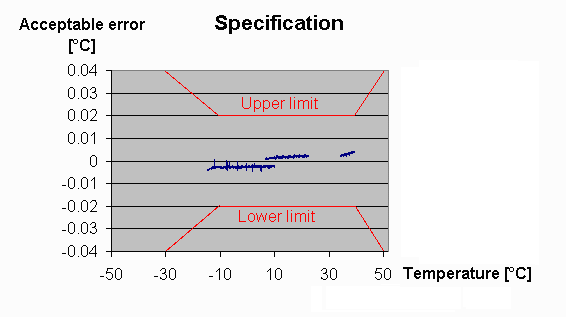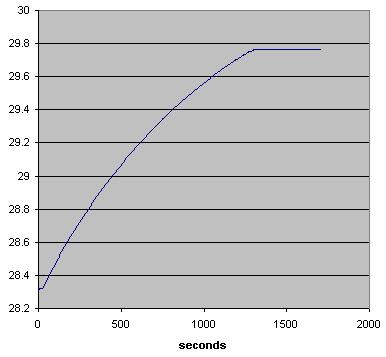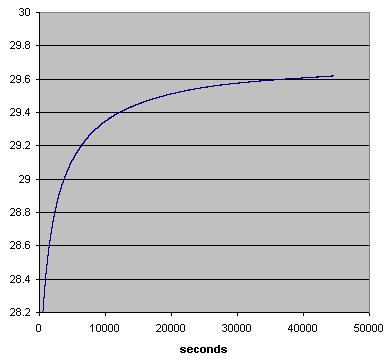|
|
Specification (including sensors).
|
|
|
Temperature resolution________________0.0005°C
Sensor calibration accuracy at 0°C_______± 0.002°C
Sensor calibration accuracy at 29.765°C___± 0.002°C
Nonlinearity -10°C to +40°C____________± 0.009°C
Electromagnetic interference___________ ±0.002°C at EN50082-1 levels.
Environment temperature dependency____± 0.002°C +0.001°C * (cable temperature - 25°C)
Selfheating in air. (Calibrated for fluid.)____ 0 to +0.006°C in still air. (Polystyrene probes.)
 Specified temperature range___________-10°C to +40°C
Temperature range___________________-50°C to +50°C
Sensor timeconstant__________________2-3s (Allow longer settling after thermal chock.)
Specified temperature range___________-10°C to +40°C
Temperature range___________________-50°C to +50°C
Sensor timeconstant__________________2-3s (Allow longer settling after thermal chock.)
When comparing the specification above with competitors please note that this
specification include sensors. Excluding sensors makes any specification look great.
Performance and sensor calibration methods have been tested rigorously.
Templabs signum is products with high reliability.
Data available with USB connection:
NTC sensor Resistance
NTC sensor Resistance
Differental temperature
Sensor serial number
Temperature
Sensor serial number
Temperature
Timestamp (seconds from start)
Measurement number
USB data output example:
..
0043091.0 0043092.0 0.0008 00140 28.3157 00139 28.3149 00001734 0000293
0043085.8 0043088.3 0.0012 00140 28.3184 00139 28.3171 00001740 0000294
0043082.3 0043084.5 0.0013 00140 28.3204 00139 28.3191 00001746 0000295
..
The output is continously stored as a file using windows terminalprogram. The file can be imported to Excel.
Please download and examine this example file:
Meaurement on pure Gallium melting point.
It is a meaurement on 99.99999% pure Gallium.
Calibration made by Templabs.
0°C +-0.001°C fixpoint used by Templabs.
The international temperaturescale from 1990 (ITS-90) uses the tripplepoint of water as a primary fixpoint,
this fixpoint is defined to be exacly +0.01°C.
Ions in water cause freezing point depression, so the water used must be clean enought for the calibration accuracy needed.
For a calibration unaccuracy of 0..-0.001°C the water need to have a conductivity less than 10uS/cm.
OK-Q8 batterywater holds around 1uS/cm and is specified to be less than 5uS/cm.
(The blottled springwater IMSDAL from Norway around 43uS/cm. Tapwater around 200 uS/cm.)
1uS/cm batterywater can be used for 0°C 0..-0.001 calibration.
Templabs is also using an ion exchanger to purify the water to well below 1uS/cm.
To have everything under control the conductivity of the water is measured both before and after calibration
to verify that the water has not become contaminated during calibration.
A sodium glass Dewar flask could for example release Na+ ions.
29.7646°C +-0.001°C fixpoint used by Templabs.
The melting point of pure Gallium is a primary fixpoint and should be 29.7646°C at normal air preasure.
If the Gallium is contaminated the temperature will drift upwards during melting.
The same apply to water as the most contamined ice will melt first, and the most pure ice will melt last.
By examining the temperature drift of Gallium the purity can be verified.
The gallium used by Templabs is very stable, better than +-0.001°C from melting onset to melted.
The pictures below show measurements on pure and unpure Gallium.
|
To the left is the measurement on 99.99999% pure Gallium. The pure Gallium is bought from American GMG INC. Note that the pure Gallium below settle at 29.7646°C in a few seconds. Certificate of analysis. (pdf)
|
To the right is a measurement on unpure Gallium. The unpure Gallium never reach a +-0.001°C stable temperature.
|

|

|
|

|
|